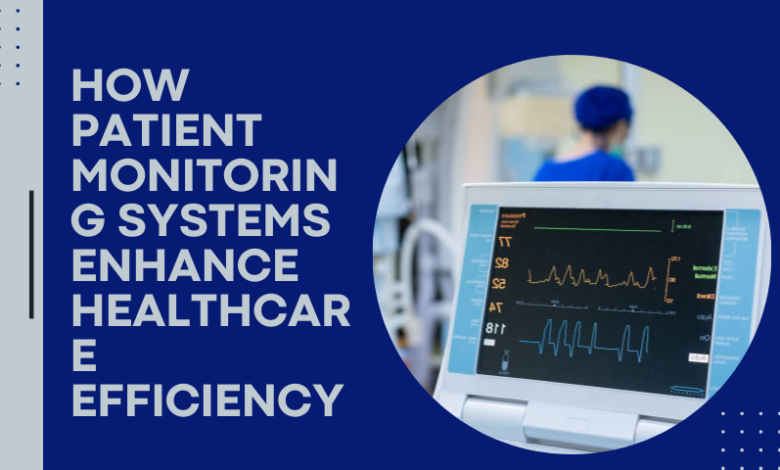How Patient Monitoring Systems Enhance Healthcare Efficiency

Patient monitoring systems have revolutionized healthcare in many ways. These systems are designed to keep track of a patient’s vital signs and other important health information. By doing so, they help doctors and nurses provide better care. In this blog, we will explore how patient monitoring systems work, their benefits, and how they enhance healthcare efficiency.
What Are Patient Monitoring Systems?
Understanding the Basics
Patient monitoring systems are electronic devices used in hospitals and clinics. These devices continuously check a patient’s health status. They track vital signs such as heart rate, blood pressure, temperature, and oxygen levels.
Note:-Looking to enhance the efficiency and quality of care in your healthcare facility? Discover the benefits of our advanced Patient Monitoring System. Visit our website today to learn more and take the first step towards smarter, safer, and more efficient healthcare!
Types of Patient Monitoring Systems
There are several types of patient monitoring systems, including:
- Bedside Monitors: These are used in hospital rooms to continuously observe patients.
- Remote Monitors: These allow doctors to check a patient’s status from a distance, even when the patient is at home.
- Wearable Monitors: These are small devices worn by patients to track their health throughout the day.
Benefits of Patient Monitoring Systems
Improved Patient Care
Patient monitoring systems play a crucial role in enhancing patient care. Here’s how:
- Early Detection of Issues: These systems can detect health problems early. This means doctors can act quickly to treat the patient, potentially saving lives.
- Continuous Monitoring: Patients are monitored 24/7, ensuring that any sudden changes in their health are immediately noticed.
Increased Efficiency for Healthcare Providers
Patient monitoring systems also make the work of healthcare providers more efficient. Here’s why:
- Reduced Workload: Nurses and doctors don’t need to manually check each patient’s vital signs as often. The monitoring system does this automatically.
- Better Data Management: These systems store health data digitally. This makes it easier to access and analyze patient information.
How Patient Monitoring Systems Work
Gathering Data

Patient monitoring systems use sensors to collect data from the patient’s body. For example, a heart monitor might use electrodes attached to the chest to measure the heart rate.
Processing Data
The data collected by the sensors is sent to a central system. This system processes the data and displays it in a readable format. Doctors and nurses can then view this data on a screen to monitor the patient’s condition.
Alerting Healthcare Providers
If the monitoring system detects any abnormal readings, it immediately sends an alert. This alert can be in the form of a sound, a light, or a message sent to a nurse’s or doctor’s phone. This ensures that any potential problems are quickly addressed.
How Patient Monitoring Systems Enhance Healthcare Efficiency
Reducing Hospital Stay Length
One of the significant ways patient monitoring systems enhance healthcare efficiency is by reducing the length of hospital stays. Here’s how:
- Faster Recovery Monitoring: Continuous monitoring allows for the early detection of improvements in the patient’s condition, leading to quicker discharges.
- Preventing Complications: By catching potential problems early, these systems prevent complications that could extend hospital stays.
Improving Resource Allocation
Efficient use of resources is crucial in healthcare. Patient monitoring systems help in this area by:
- Optimizing Staff Time: Nurses and doctors can focus on patients who need the most attention, rather than spending time on routine checks.
- Better Equipment Utilization: healthcare Monitoring systems can indicate which equipment is needed, ensuring that hospital resources are used efficiently.
Enhancing Patient Safety
Patient safety is a top priority in healthcare. Monitoring systems contribute to patient safety in several ways:
- Continuous Surveillance: Patients are under constant watch, reducing the risk of unnoticed deterioration in their condition.
- Timely Interventions: Alerts from the monitoring system ensure that healthcare providers can intervene promptly if there is an issue.
The Future of Patient Monitoring Systems
Technological Advancements
Technology is continually evolving, and patient monitoring systems are no exception. Here are some future trends:
- Artificial Intelligence (AI): AI can analyze data more quickly and accurately than humans, potentially predicting health issues before they occur.
- Internet of Things (IoT): IoT-enabled devices can connect multiple monitoring systems, providing a comprehensive view of the patient’s health.
Integration with Electronic Health Records (EHR)
Integrating patient monitoring systems with EHR can enhance healthcare efficiency further by:
- Seamless Data Flow: Automatic data entry into EHR systems saves time and reduces errors.
- Comprehensive Health Profiles: Combining monitoring data with other health records gives a complete picture of the patient’s health, aiding in better treatment decisions.
Challenges and Solutions in Implementing Patient Monitoring Systems
Initial Costs
One of the primary challenges in implementing patient monitoring systems is the initial cost. However, the long-term benefits often outweigh these costs. Here’s how:
- Investment Returns: Reduced hospital stays and better resource management lead to cost savings in the long run.
- Improved Patient Outcomes: Better patient care results in fewer complications, reducing treatment costs.
Data Security
Protecting patient data is crucial. Patient monitoring systems must ensure that sensitive health information is secure. Solutions include:
- Encryption: Data should be encrypted to prevent unauthorized access.
- Regular Audits: Conducting regular security audits can help identify and fix vulnerabilities.
Training Healthcare Providers
Healthcare providers need proper training to use patient monitoring systems effectively. This can be achieved by:
- Comprehensive Training Programs: Offering detailed training sessions for all staff members.
- Ongoing Support: Providing continuous support and refresher courses to keep staff updated on new features and best practices.
Conclusion
Patient monitoring systems are transforming healthcare by enhancing efficiency and improving patient care. They reduce the workload on healthcare providers, allow for better resource allocation, and ensure continuous patient monitoring. As technology advances, these systems will become even more integral to healthcare, offering more sophisticated tools for patient care.
By understanding how these systems work and the benefits they offer, healthcare providers can make informed decisions about implementing and using patient monitoring systems to their full potential. This not only improves patient outcomes but also ensures that healthcare facilities run more efficiently and effectively.
Read more informative blog at usafulnews).



